Top 5 Alternatives to Traditional Hardwood Floors

While beautiful, not every lifestyle is conducive to hardwood – it’s not always budget friendly, it’s prone to scratching, and not water resistant.
So, what options do you have if you love the look of hardwood floors, but need something better suited to the way you live? Let’s explore some of the best alternatives to hardwood floors.
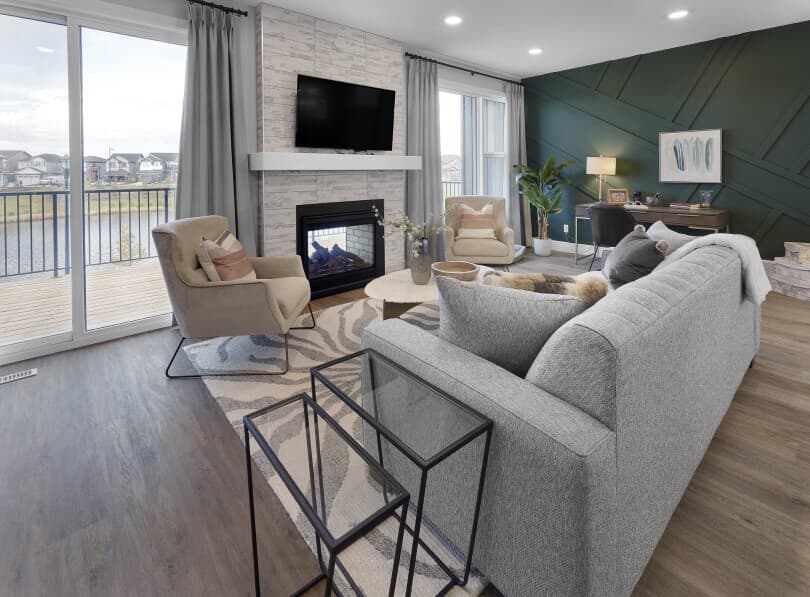
1. Laminate flooring
Laminate flooring has come a long way from what it was in the past. Modern laminate planks are a hybrid floor covering consisting of a particleboard wood base topped by an image layer and a transparent wear layer. It’s inexpensive, durable, and comes in a wide variety of styles and colors. Because it’s “clickable” (or a “floating floor”), it can easily be installed on top of tile or concrete flooring.
While it’s not waterproof, it is water resistant so it can be used in high-traffic areas like kitchens and hallways. Laminate is also stain- and fade-resistant so you don’t have to worry about spills or sunlight taking their toll on your flooring.
Although not guaranteed to last a lifetime, the initial cost and ease of maintenance is a trade off most homeowners are willing to make. Laminate can easily be swept and mopped as needed – just be sure not to oversaturate, use abrasive cleaners, or products that may cause slipping once dry.
Pros of Laminate Flooring
- Easy to clean and install
- Scratch-, stain-, and fade-resistant
- Good for homes with pets and children
- Budget friendly
Cons of Laminate Flooring
- Not suitable for moisture prone areas (bathrooms or laundry rooms)
- If scratched, cannot be refinished
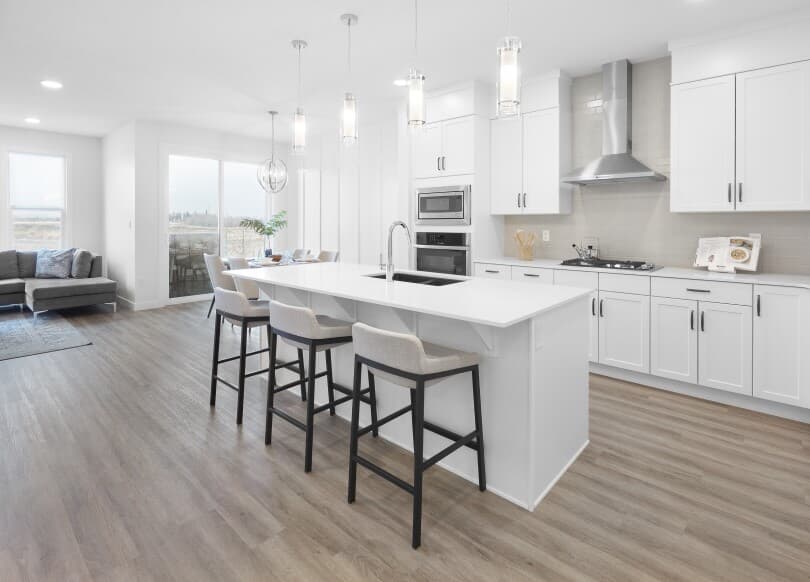
2. Luxury vinyl planks
Vinyl flooring often gets a bad rap as it evokes a mental image of rolled out sheets printed with tacky patterns (grandma’s kitchen in the ‘70s anyone?). Nowadays, vinyl plank flooring has had the glow-up it deserves. Modern planks not only look and feel like real hardwood, but are waterproof, meaning you can use them throughout your entire home for a beautiful, cohesive feel.
Much like laminate, it clicks together for easy installation and can be placed directly on top of concrete or tile flooring. It is also incredibly durable, easy to clean, and scratch- and fade-resistant. Unlike laminate, which is more likely to absorb moisture, luxury vinyl planks hold up to water.
Pros of Vinyl Flooring
- Waterproof
- Easy to clean and install
- Scratch-, stain-, and fade-resistant
- Good for homes with pets and children
- Budget friendly
- Can be used in your entire home
Cons of Vinyl Flooring
- Susceptible to gouges and dents
- If glued down, it can be very hard to remove if you ever want to replace
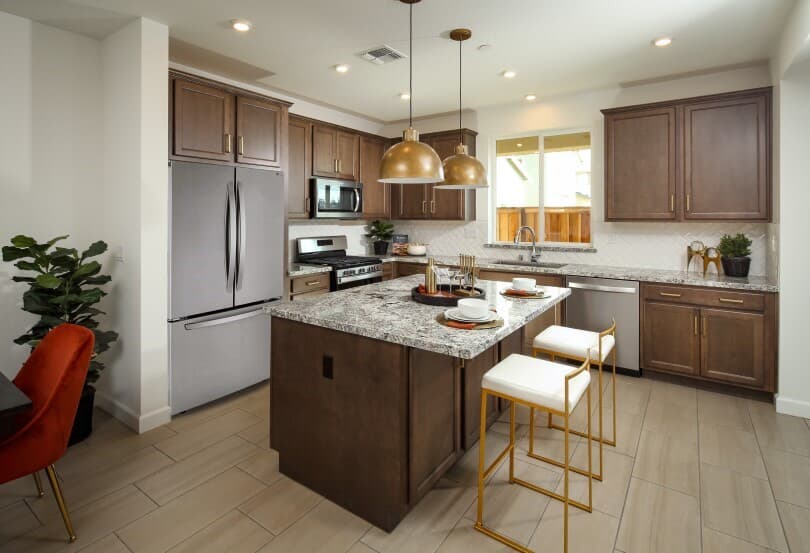
3. Wood-look tile
Tile itself is extremely durable, so when coupled with a wood-like design, the end result is a timeless look and feel that will last for decades. This means that not only can you use wood-look tile throughout your entire home including the bathrooms, you can flow it outside to your porch or patio for a truly seamless indoor-outdoor living experience.
While tile seems relatively easy to install, it may not be the best DIY project. Laying tile is easy but laying tile and doing it well is difficult. You need the right materials, the proper tools, and plenty of patience to ensure everything is lined up properly. While not impossible, laying tile may not be the right project for a novice.
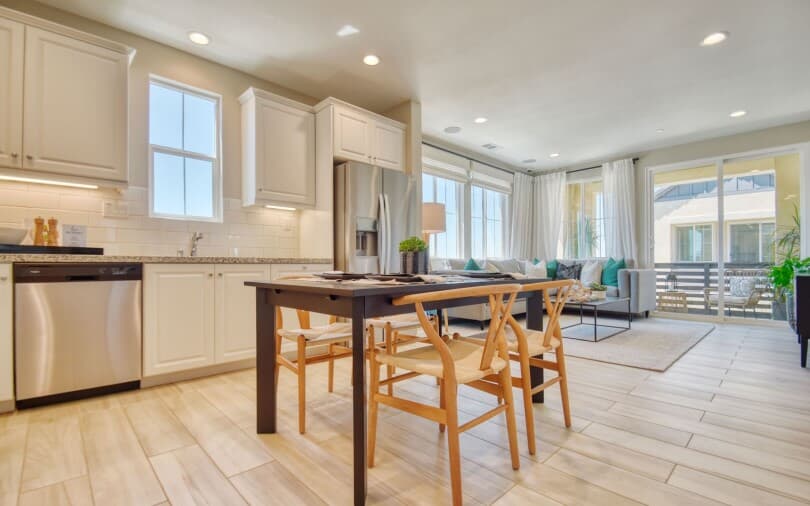
Wood-look tile has been increasing in popularity resulting in even more shades, textures, and styles becoming available. Higher end products may even be distressed or hand-scraped for a more authentic look and feel.
Tile is a low-maintenance product with only vacuuming and mopping required as needed, but you may want to do a thorough deep-cleaning to restore its original luster every so often. Thick grout is a dead giveaway that your flooring isn’t real hardwood so keep the grout lines very thin and be sure to seal it in your moisture-prone rooms to prevent the growth of mold and mildew.
Pros of Wood-Look Tile
- Incredibly durable
- Waterproof
- Good for homes with pets and children
- Stain-, slip-, and scratch-resistant
- Individual tiles can be replaced if damaged
- Easy to clean
- Budget friendly
- Can be used indoors and outdoors
Cons of Wood-look Tile
- More challenging to install
- Unless you install radiant heat, tile is cold underfoot
- Heavy material so not ideal for upper story installation
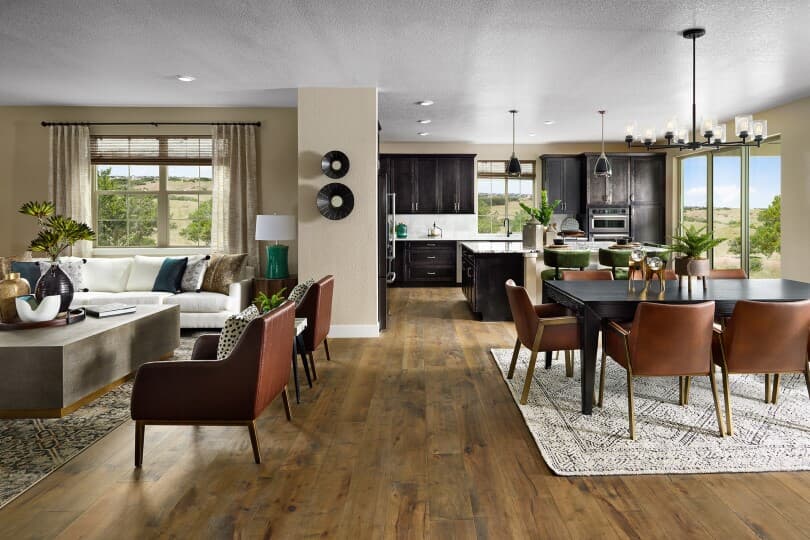
4. Engineered hardwood
Engineered wood flooring is similar to laminate in that it has multiple layers, but instead of a photographic layer on top, there is a thin slice of real wood. If you have a particular hardwood you’ve fallen in love with, but your budget won’t allow for the real deal, chances are you can easily find it in an engineered form. While it isn’t 100% hardwood flooring, it isn’t far from it and most people won’t be able to tell the difference once it’s installed.
Similar to laminate, engineered hardwood is moisture-resistant meaning it’s great for most of your home, but not for your bathrooms or laundry area. Unlike laminate flooring, engineered wood can be sanded down and refinished, but only once or twice in its lifetime.
Engineered hardwood can be installed in a few different ways. Some products are designed for glue-down application meaning the job is better suited to a professional, and some products are nail-down installation or floating-floor which can be done yourself.
One of the biggest drawbacks to engineered hardwood is the high level of maintenance it requires to keep its shine – similar to the care real hardwood requires. Unless you’re prepared to keep up with regular maintenance, this product isn’t well-suited to homes with pets and children.
Pros of Engineered Hardwood
- Temperature and moisture resistant
- More budget friendly compared to real hardwood
- More authentic look and feel of hardwood
- Can be refinished if the veneer is thick enough
Cons of Engineered Hardwood
- Limited resurfacing
- High level of maintenance
- Prone to fading, scratches, and dents
- Not as budget friendly compared to other hardwood alternatives
- Not suited for homes with pets and children

5. Bamboo flooring
Bamboo flooring is considered to be a more eco-friendly and sustainable option compared to real hardwood. While trees can take decades to mature, bamboo grows (and regrows after it has been cut) very quickly.
Bamboo flooring is engineered and glued together making it similar to engineered hardwood – without the maintenance. This flooring doesn’t need to be sealed and only requires vacuuming and mopping as needed.
Bamboo can be used in virtually any room, but is not ideal for spaces prone to standing water like bathrooms or basements. While bamboo can come in a variety of colors, it naturally leans to lighter tones. Without staining, bamboo has a blonde tone. With staining or carbonization, colors may range from tan to light brown, but you typically won’t find dark, rich tones.
Pros of Bamboo Flooring
- Durable
- Dent-, water-, and scratch-resistant
- Easy to clean
- Environmentally friendly compared to hardwood
- Good for homes with pets and children
- Can be refinished if the planks are thick enough
Cons of Bamboo Flooring
- Subfloor must be perfectly smooth as bamboo will show imperfections
- Inexpensive bamboo flooring is susceptible to scratches and dents
- Can be discolored if it gets too much direct sunlight
- More prone to issues caused by humidity
- Limited colors

As beautiful as hardwood flooring is in any home, the durability, versatility, and price tag doesn’t always make sense for every household. Fortunately, there are plenty of alternatives to create a similar look and feel ensuring the end result is something you’ll love for years to come.
Designing your dream home is one of the more fun aspects in the homebuying process. We offer products and finishes that will truly express your individual tastes and lifestyle as well as professional guidance to ensure a look that is sure to fulfill your vision.
Be sure to follow the Brookfield Residential blog for more design advice, homebuying insights, mortgage tips, and more. Explore where we build and come visit us when you’re ready to learn more. We’ll be expecting you!